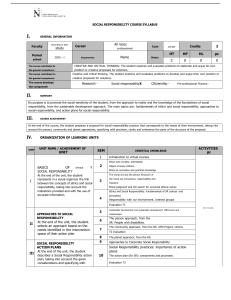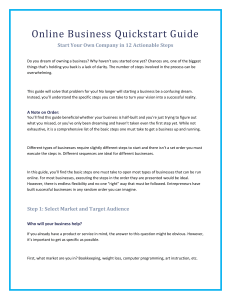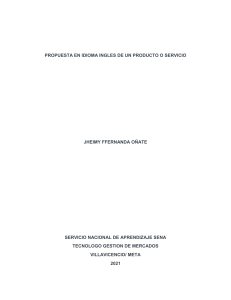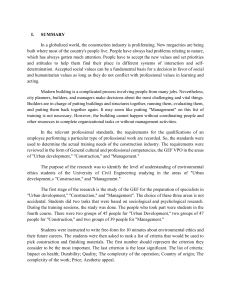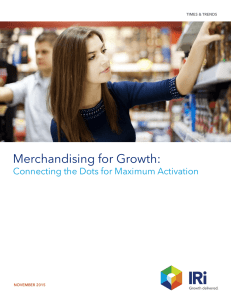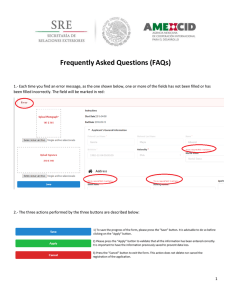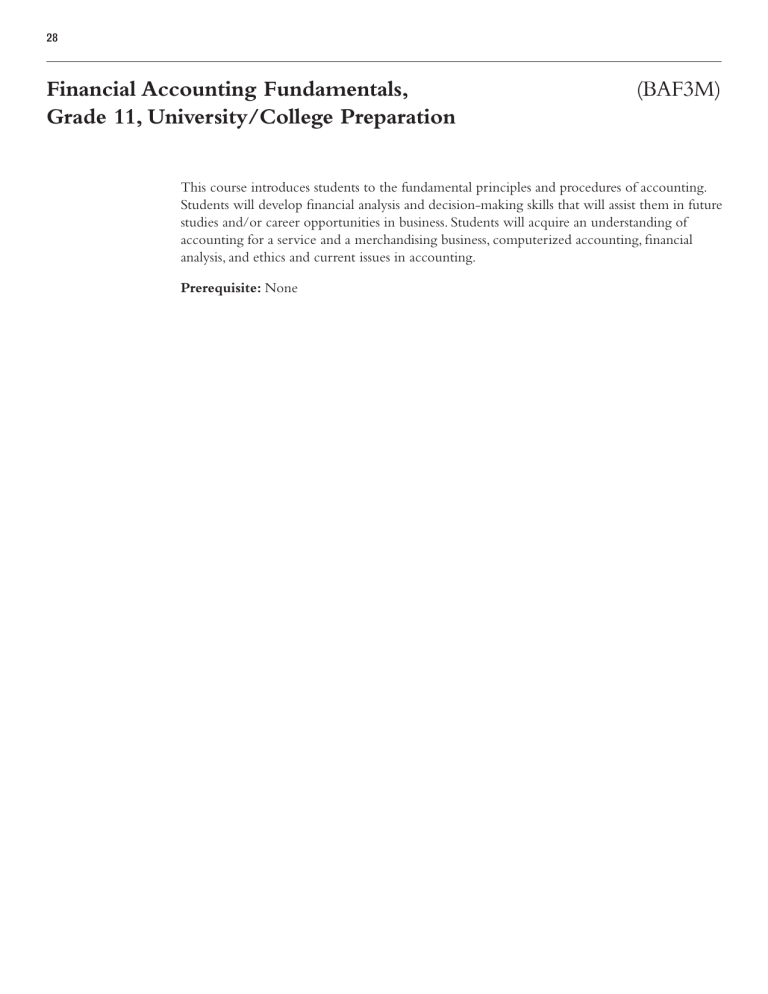
28 Financial Accounting Fundamentals, Grade 11, University/College Preparation (BAF3M) This course introduces students to the fundamental principles and procedures of accounting. Students will develop financial analysis and decision-making skills that will assist them in future studies and/or career opportunities in business. Students will acquire an understanding of accounting for a service and a merchandising business, computerized accounting, financial analysis, and ethics and current issues in accounting. Prerequisite: None FINANCIAL ACCOUNTING FUNDAMENTALS, GRADE 11, UNIVERSITY/COLLEGE PREPARATION (BAF3M) 29 Fundamental Accounting Practices Overall Expectations By the end of this course, students will: • describe the discipline of accounting and its importance for business; • describe the differences among the various forms of business organization; • demonstrate an understanding of the basic procedures and principles of the accounting cycle for a service business. Specific Expectations Introduction to Accounting as a Discipline By the end of this course, students will: The Accounting Cycle for a Service Business By the end of this course, students will: – explain the purpose of accounting; – assess the effects that transactions have on the accounts and financial statements of a service business; – explain the difference between accounting and bookkeeping; – identify the users and uses of accounting; – identify the Generally Accepted Accounting Principles (GAAP) and explain their importance. Business Structures By the end of this course, students will: – describe the characteristics of different forms of business organization, including sole proprietorship, partnership, and corporation; – describe the advantages and disadvantages of different forms of business organization, including sole proprietorship, partnership, and corporation; – explain the differences among the equity sections of different forms of business organization, including sole proprietorship, partnership, and corporation (e.g., capital account in a sole proprietorship versus common stock in shareholders’ equity in a corporation). – record transactions using the journals and ledgers of a service business; – prepare a trial balance and the financial statements for a service business; – record adjusting and closing entries for a service business (e.g., prepaid expenses, amortization, accruals); – describe the impact of year-end procedures, including adjusting and closing entries, on the financial statements of a service business; – apply the Generally Accepted Accounting Principles (GAAP) at each stage of the accounting cycle for a service business. 30 THE ONTARIO CURRICULUM, GRADES 11 AND 12: BUSINESS STUDIES Advanced Accounting Practices Overall Expectations By the end of this course, students will: • demonstrate an understanding of the procedures and principles of the accounting cycle for a merchandising business; • demonstrate an understanding of the accounting practices for sales tax; • apply accounting practices in a computerized environment. Specific Expectations The Accounting Cycle for a Merchandising Business By the end of this course, students will: – describe the principal accounting elements particular to a merchandising business (e.g., new accounts, cost of goods sold section, returns, discounts); – identify and describe the periodic and perpetual inventory systems and journalize transactions using both systems; – assess the effects that transactions have on the accounts and financial statements of a merchandising business; – record transactions in the journals and ledgers of a merchandising business; – prepare a trial balance and the financial statements, including a detailed cost of goods sold section, for a merchandising business; – record the adjusting and closing entries for a merchandising business (e.g., accruals, inventory adjustment); – describe the impact of year-end procedures, including adjusting and closing entries, on the financial statements of a merchandising business; – describe alternative accounting practices (e.g., special journals and ledgers). Accounting for Sales Tax By the end of this course, students will: – describe the accounting practices particular to sales tax (e.g., accounts required, financial statement presentation); – record transactions related to provincial sales tax (e.g., collections, remittance); – record transactions related to federal sales tax (e.g., collections, remittance). Computer Applications in Accounting By the end of this course, students will: – use accounting or application software to record transactions for a service business; – use accounting or application software to record transactions for a merchandising business; – use accounting or application software to prepare financial statements. FINANCIAL ACCOUNTING FUNDAMENTALS, GRADE 11, UNIVERSITY/COLLEGE PREPARATION (BAF3M) 31 Internal Control, Financial Analysis, and Decision Making Overall Expectations By the end of this course, students will: • demonstrate an understanding of internal control procedures in the financial management of a business; • evaluate the financial status of a business by analysing performance measures and financial statements; • explain how accounting information is used in decision making. Specific Expectations Internal Control Procedures By the end of this course, students will: – describe the basic elements of an internal control system (e.g., separation of duties, prenumbered documents, rotation of staff); – apply appropriate control measures used in accounting for assets (e.g., petty cash procedures, bank reconciliation procedures); – describe the role of budgeted financial statements in planning, controlling, and evaluating business results (e.g., difference between budgeted and actual income statements); – describe the role and work of an auditor. Financial Analysis By the end of this course, students will: – explain the importance of current assets and current liabilities when interpreting a balance sheet; – analyse a company’s liquidity and solvency by using simple financial ratios (e.g., current ratio, debt ratio) and other financial analysis tools (e.g., comparative statements, trend analysis, common size statements); – analyse a company’s profitability by using simple financial ratios (e.g., gross profit percentage, return on equity) and other financial analysis tools (e.g., comparative statements, trend analysis, common size statements). Decision Making By the end of this course, students will: – describe how accounting information is used by company personnel (e.g., department managers, owners) in making decisions; – explain the role of financial analysis in decision making from the standpoint of potential investors (e.g., mutual fund managers, institutional investors, individual investors); – describe how accounting information is used by individuals or organizations outside the company (e.g., governments, Ontario Securities Commission, police, forensic accountants) in making decisions. 32 THE ONTARIO CURRICULUM, GRADES 11 AND 12: BUSINESS STUDIES Ethics, Impact of Technology, and Careers Overall Expectations By the end of this course, students will: • assess the role of ethics in, and the impact of current issues on, the practice of accounting; • assess the impact of technology on the accounting functions in business; • describe professional accounting designations and career opportunities. Specific Expectations Ethics and Current Issues By the end of this course, students will: Careers in Accounting By the end of this course, students will: – describe the role of ethics in accounting; – distinguish among the professional accounting designations in Canada and the corresponding areas of specialization for accountants (e.g., financial accounting, management accounting, auditing); – explain the need for strict standards (e.g., code of conduct) in the practice of professional accounting; – identify and describe current issues and developments that have an impact on accounting and the accounting profession (e.g., fraud scandals, the globalization of business transactions). Impact of Technology By the end of this course, students will: – compare a manual accounting system with a computerized accounting system; – describe ways in which technology can affect the accounting function (e.g., the effect on the information itself, the accountant’s work, and the security of information systems); – explain the advantages and disadvantages of technology as it affects accounting. – identify the Canadian accounting organizations and describe the services they offer to support accountants; – identify and describe various accounting career opportunities that do not require professional accounting designations; – summarize, on the basis of research, the educational requirements of various career paths requiring a background in accounting.



